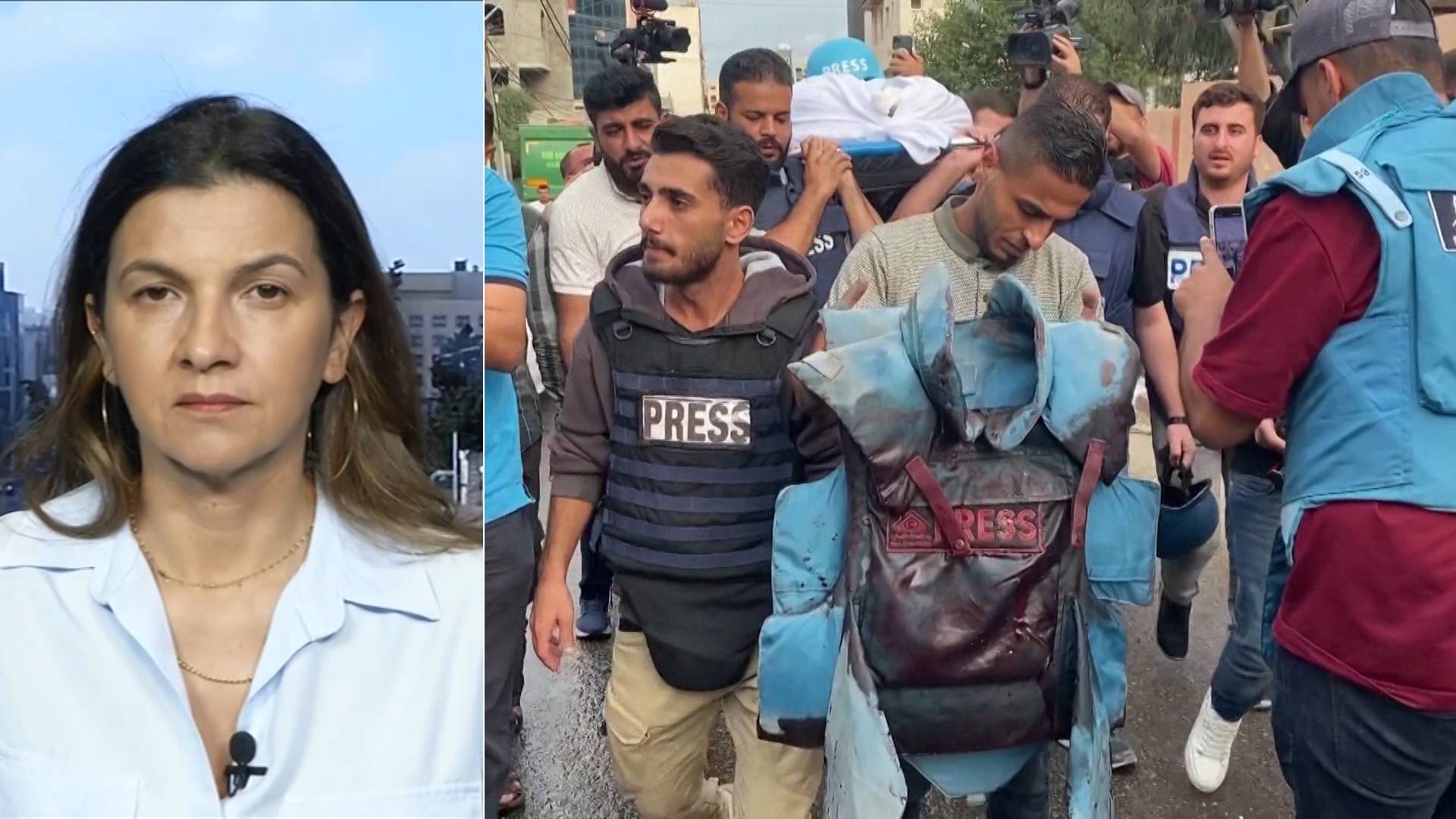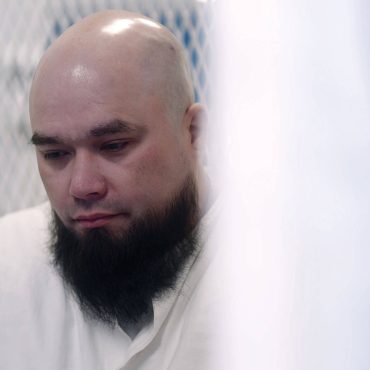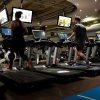This is a rush transcript. Copy may not be in its final form.
AMY GOODMAN: This is Democracy Now!, democracynow.org, The War and Peace Report. I’m Amy Goodman, with Nermeen Shaikh.
NERMEEN SHAIKH: Gaza is the deadliest place on Earth for journalists, by far. According to the Committee to Protect Journalists, over a hundred Palestinian journalists have been killed in Gaza since October. The Palestinian Journalists’ Syndicate puts the figure even higher at 140 journalists and media workers killed since the start of the war. According to the group, the deaths represent 10% of all journalists in Gaza.
Now a new collaborative investigation called the Gaza Project, by the nonprofit group Forbidden Stories, brings together 50 journalists from 13 different news organizations to investigate the targeting of journalists in Gaza and the West Bank.
AMY GOODMAN: According to the findings of the Gaza Project, at least 40 journalists and media workers in Gaza were killed while at home. At least 14 journalists were wearing press vests at the moment they were killed, injured or allegedly targeted. At least 18 journalists were killed, injured or allegedly targeted by drones, and six buildings housing media offices were completely or partially destroyed.
For more, we’re joined by Hoda Osman. She is the executive editor for Arab Reporters for Investigative Journalism, which was a partner organization in the Gaza Project. Hoda Osman is also the president of the Arab and Middle Eastern Journalists Association. She’s based in New York but today is joining us from Amman, Jordan.
We thank you so much for being with us. We know that there is a delay in this broadcast. Can you start off by talking about the scope of the project and your major findings, Hoda?
HODA OSMAN: Thank you very much for having me here today to speak about this important project.
We started the project — we started talking about this months ago. It was a shock to all of us that — just like the pure numbers. The scale of the killings of the journalists in Gaza was beyond any imagination. And by any standard, it’s unprecedented. World War II, Vietnam, the Iraq War, nothing like this had ever happened to journalists before. It’s a crisis is not just for Palestinian journalists or Arab journalists, but it should be a crisis for journalists worldwide, the journalists’ community. And to be honest, we weren’t seeing the outcry, the sort of the reaction that this crisis deserves.
So, I have to give credit to Forbidden Stories, the nonprofit based in Paris, whose mission is to complete stories for journalists who can’t complete them, either because they’ve been killed or censorship or detained. They brought us together to work on this project, as you mentioned, 50 journalists, 13 organizations.
And in the beginning, when we started, really all we had was this, like, huge and tragic number, over a hundred journalists killed. And we started from there. We wanted to investigate these killings. We started off by actually dividing the cases amongst us to look into every case and look into which investigations could come out of this project.
And I can speak about some of the main findings, which included — I feel like maybe one of the main results is just like collectively, by having worked on this for so many months, and all of us together, to sort of push back against the claim, the Israeli claim, that journalists have not been targeted, and to show, through the different investigations that we’ve produced — I think over 20 articles and reports have been published by the different organizations — that there is a systematic attack on journalists in Gaza and the West Bank, too. We actually have two stories out of the West Bank, including a story about a specific attack on a TV crew in the West Bank. So, collectively, just by looking at all the investigations together, you can clearly see that this is not just random, or the notion that because of the scale of the destruction and the war in Gaza, that this is just a natural result. And when you look at these investigations, you will come to this conclusion.
But also, I’m happy to speak about some of the specific findings and some of the specific stories that we’ve worked on, if you’d like me to.
NERMEEN SHAIKH: Yes, Hoda, we would like you to speak about some of the specific stories. Maybe you could begin with the directed attacks against the AFP office, which you wrote about at length. And also explain how all of these different — because you have some of the leading media organizations in the world who were involved in this, from Le Monde to Der Spiegel, etc. How did you all coordinate your work together? And then speak about what happened at the AFP office.
HODA OSMAN: So, let me start by how we all worked together. Forbidden Stories was critical in managing this project. You can imagine 50 journalists in several different countries. So, coordinating this project is definitely a challenge. But we all worked on all the stories. So, once we’ve determined — after the initial stage of doing some research about the different cases, once we’ve identified certain leads that we were going to follow, we created these subgroups, and anybody who’s interested in one of these leads would join this group. And then we all — we did what we refer to as radical sharing. Everybody was just radically sharing whatever they were doing. I was doing interviews. Somebody else was doing, like, forensic visual analysis. Someone else had access to documents. And everybody shared everything. And that’s how — it’s the power, really, of this investigation. I wouldn’t have been able to do it alone. ARIJ, my organization, wouldn’t have been able to do it alone. And none of the other organizations would have been able to do it by themselves, as well.
Let me speak about, like, one of our major findings. On November 2nd, the AFP offices in Gaza, there was an explosion there. And the result was a huge gaping hole that you can see from the outside, but also on the inside a lot of damage. AFP regularly, as a common practice for foreign offices in Gaza, send their map coordinates, their location, to the Israeli military to tell them that this is a media office and it’s not to be targeted. So, when asked about what had happened, initially the Israeli army said that — you know, they didn’t recognize that anything had happened. Then they said maybe there were clashes, and this was like as a result of the debris. And there were the condemnations and, you know, requests for investigations, but then nothing really happened.
And then we started looking into this. What we had, really, to work on this was the live footage from the camera that was stationed in the AFP offices. When the staff left in October after the Israeli evacuation orders, they left an unmanned camera that was connected to solar power. And these explosions were caught on camera on the live feed. And we were able to identify four strikes. And through analysis that was done by both Le Monde and Paper Trail Media, an organization in Germany that was part of this collaboration, and which was confirmed by an audio analysis done by an organization specializing in audio investigations and by six weapons experts, we were able to determine that this was actually direct firing by an Israeli tank from around three kilometers away. We’ve identified the specific area that the firing happened from. And we were able to get satellite imagery that showed that two days before and the day after, there were tanks in this area.
And then, while we were looking at all of this, I came across a story of a journalist who had been injured, and I noticed that he was injured on November 2nd in an attack on a local media company called the Palestine Media Group, PMG. And then we found out that they were actually on the same street, just a few hundred meters away, in this tall building, the tallest building in Gaza, on the 16th floor. So, we found out what time this other attack had happened, and it turned out it had happened about an hour before the AFP attacks. And actually, I remember this moment. We were in a meeting, a virtual meeting, with the AFP, who — the AFP team was working with us on this particular story. And we were, like, you know, checking the — kind of the range of time. Let’s check the live feed around this time. And we found that it was caught live on camera.
So, there were two attacks on two buildings: four strikes on AFP, at least one strike that we know of on the offices of PMG in this other building. The difference between the two is that at the PMG offices, there were four people, including two journalists, and one of them got badly injured in his leg.
So, this was one of our main findings. The Israeli military, in its — we, of course, approached the military for a response before we published. And in its response, it still insisted that there was no targeting of the office.
NERMEEN SHAIKH: And, Hoda, could you also speak — two of the other critical stories you covered were the attacks on the Press House, Press House-Palestine. Explain what Press House did, the services it provided to journalists in Gaza, and what happened.
HODA OSMAN: So, one of our other major stories, and this one we worked closely with The Guardian on, was about Press House. It’s this very unique and special organization in Gaza, that was considered by many as a second home to journalists. It provided a lot of training and workshops to journalists and a lot of services. It was created by a man called Bilal Jadallah in 2013, so last year would have been the 10-year anniversary. And journalists would go there to attend workshops, to attend discussions. It was also considered a place — like, any foreign dignitary that would visit Gaza would definitely go to visit Press House and to visit Bilal Jadallah. And we heard a lot about the breakfasts that they held in their garden. The pictures from before, really, when you see them and when you look at them, it’s quite disheartening to see what’s happened to Press House since then.
So, after the war — Press House had actually secured 84 flak jackets and press helmets before the war. So, when the war started, they sent out a message to the journalists, saying, “We have this protective gear. You can come to Press House, and you can start getting it.” And they started giving the journalists this protective gear. They also opened up their offices. They had strong internet. They were connected to solar power. And journalists started working from Press House for the first few days. And then the evacuation orders happened in October, on October 13th. Some of the journalists left to the south, and some journalists stayed in Gaza City, including Bilal Jadallah, who didn’t want to close Press House and wanted to be there to continue serving the journalists.
Within two weeks, from November 6th until November 13th, three Press House staff, journalists, were killed. On November 6th, Mohamed Al Jaja was killed in his home with his family. On November 13th, Ahmed Fatima was in the home of his in-laws. A missile hit the building. His son was injured. He took his son outside to — ran to take him to the hospital, and then Ahmed himself was killed with — supposedly with a drone. And then, on November 19th, Bilal Jadallah, who had insisted until this moment to stay in Gaza City, decided that he was going to go south and meet up with his family, who had already left Gaza City. He took a route that was designated clearly by the Israeli military as a safe route to head south. There’s these maps that were being distributed and posted on Facebook, and they had this route in yellow, clearly saying you can take this route to go south. And he was in the car, and he was killed with — there was an explosion. We think it was a tank shell. And Bilal Jadallah was killed that day.
In addition to that, to the three — of course, a big, huge loss. You speak to anyone in Gaza and you mention Bilal Jadallah and you mention Press House — and the day that Bilal was killed, you know, you can — I remember speaking to several journalists on that day in November, and just, like, the shock was beyond — the loss is really insurmountable.
We also managed to speak to a witness who stayed in Press House. He’s the former financial director and a good friend of Bilal Jadallah. And at some point he had to flee his home, and he went and he stayed in the building that housed Press House, for a few weeks. And during his stay, an Israeli tank came and stood directly in front of Press House and fired at Press House. They were fortunately not harmed, this person and his family. But then, the following day, they left. And a few days later, Press House was completely demolished. And you can see the pictures. And it’s quite sad to see the pictures of this lively, like, you know, buzzing place with the journalists in it, and then you see it now, and it’s just like rubble.
AMY GOODMAN: Hoda Osman, we only have a minute to go, but I wanted to ask you about this other crucial story that appeared in The Guardian that was headlined “’The grey zone’: how IDF views some journalists in Gaza as legitimate targets.” If you can explain very briefly?
HODA OSMAN: So, the news organization that lost — the media organization that lost the most journalists was Al-Aqsa, which is considered to be affiliated with Hamas. And Harry Davies, who’s the reporter on the story, looked into this and spoke to a spokesperson from the Israeli military, who said, “Yes, we consider people who work for this media organization as terrorists and legitimate targets.” But then, after the publication of the story, the Israeli military kind of retracted and said that this spokesperson does not represent our views, and that’s not our view. But the fact is that the majority of the journalists who had been killed are journalists who had worked for this media organization that is affiliated with Hamas.
NERMEEN SHAIKH: And towards the end of your report, Hoda, you talk about the journalists who have survived so far and what their conditions are. If you could explain what you found out from them, the people they’ve lost, the number of times they’ve been displaced?
HODA OSMAN: Thank you, Nermeen, because a lot of the time the attention is, of course, on this, like, huge number, but it’s important to pay attention also to the journalists who are still there. We did a survey. Over 200 journalists responded. And it’s just like — it’s tragic. Ninety-eight percent had been displaced. Many, many have lost family members. Around 50 had lost immediate family members, including, tragically, 11 journalists who lost one or more of their children. In addition to that, their homes have been destroyed. They’ve lost — half of them had lost their jobs. A lot of them lose their jobs because they lose the equipment that they use to report. So, it’s really, really bad for the journalists who are there right now, especially when no foreign journalists are being allowed into Gaza to assist and to help with the reporting. We depend fully on these journalists, who are reporting the story, but they are the story themselves.
AMY GOODMAN: You write at the end of your article in The Intercept, quote, “Roshdi al-Sarraj, a journalist who ran an independent media company that did work for the BBC and Le Monde, wrote on October 13 on Facebook that he intended to defy an Israeli army order to evacuate Gaza City.” He said, “’We will not leave … and if we leave, we will go to the sky, and only to the sky,’ he wrote in his post. Nine days later, al-Sarraj was killed by an Israeli airstrike on his home in the Gaza City neighborhood of Tal al-Hawa.”
I want thank you so much, Hoda Osman, for joining us, executive editor of Arab Reporters for Investigative Journalism, a partner organization in the Gaza Project, also president of the Arab and Middle Eastern Journalists Association, joining us from Amman, Jordan. But we’re going to turn right now to our next guest in Gaza.
NERMEEN SHAIKH: As we continue to look at the targeting of journalists in Gaza, the deadliest place on Earth for journalists, we go now directly to Gaza to speak with a Palestinian journalist who’s at the heart of this story. Shrouq Aila is an independent journalist and producer in Gaza. Her husband, Roshdi Sarraj, was also a journalist who founded the local production company Ain Media.
AMY GOODMAN: On the morning of October 22nd, Shrouq and Roshdi were at their home in Gaza City with their 11-month-old baby girl when an Israeli airstrike hit their building. Roshdi was killed in the attack. In the months since, Shrouq has continued to work as a journalist and runs Ain Media herself. Like so many other families in Gaza, she has also been forcibly displaced several times. Shrouq is joining us from outside Al-Aqsa Hospital in Deir al-Balah.
Hoda quotes your husband and what he said, the head of Ain Media, which you have now taken over after his death. Can you talk about what happened to your him and what you’re doing on the ground there in Gaza as you try to continue his work? And explain what’s happening there every day.
I think we may have lost — we are just seeing an image of Shrouq, but she seems to have lost our signal. We’re going to go to a break, and then hopefully we’ll have her back when we come back. This is Democracy Now!, democracynow.org, committed to bringing you voices not just about Gaza, but from Gaza, and sometimes we have difficulty connecting. Stay with us.











Post comments (0)